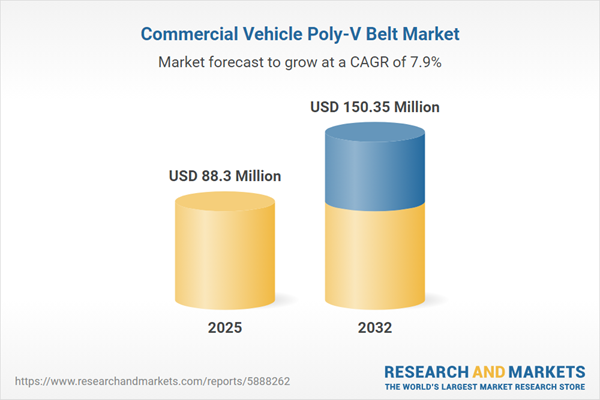Speak directly to the analyst to clarify any post sales queries you may have.
The commercial vehicle poly-V belt market is undergoing rapid transformation as fleets respond to regulatory complexity, evolving drivetrain technologies, and an increased focus on cost control. Senior decision-makers are seeking proven procurement strategies and performance standards to ensure fleet reliability in this shifting landscape.
Market Snapshot: Commercial Vehicle Poly-V Belt Market Overview
Fuelled by significant innovation in drivetrain systems and more meticulous maintenance priorities, the commercial vehicle poly-V belt market is expanding from USD 81.69 million in 2024 to USD 88.30 million in 2025, with a projection of USD 150.35 million by 2032, reflecting a robust compound annual growth rate (CAGR) of 7.92%. This growth is attributed to increasing demand for versatile and robust belt technologies, the ongoing modernization of commercial vehicle platforms, and heightened adherence to global compliance requirements across multi-sector operations. Investment in advanced belt design remains critical for supporting the sophisticated requirements of contemporary powertrains.
Scope & Segmentation: Strategic Insights for Fleet Solutions
- Vehicle Types: Heavy-duty poly-V belts serve transit and load-bearing vehicles such as buses and dump trucks, while medium-duty solutions are tailored for box trucks and pickups. Light-duty variants address the unique needs of minivans and chassis cabs. Fleet managers must align belt selection with operational environment and installation demands to maximize uptime.
- Sales Channels: Sourcing options include aftermarket providers, direct manufacturer partnerships, original equipment manufacturer (OEM) distributors, and digital marketplaces. Each procurement channel offers distinct advantages regarding inventory agility, procurement speed, and supply chain control.
- Material Types: EPDM and neoprene compositions are prevalent, with single-rib and multi-rib configurations ensuring resilience under shifting temperature and load profiles. Careful selection of material supports longer lifecycle expectations and operational reliability.
- End-User Industries: Key sectors utilizing poly-V belts include agriculture, logistics, construction, mining, and manufacturing. Maintenance schedules and service intervals must be customized per industry to safeguard uptime and contain operational expenditures.
- Regions Analyzed: The Americas, EMEA, and Asia-Pacific are major regions examined. Regional procurement priorities vary, with the Americas focused on flexible sourcing, EMEA emphasizing regulatory adherence, and Asia-Pacific driving fleet expansion and adaptation.
- Key Companies Profiled: Benchmarking includes leading suppliers such as Continental AG, The Gates Corporation, Dayco Products LLC, Bando Chemical Industries, Mitsuboshi Belting Ltd., Sumitomo Riko Company Limited, Optibelt GmbH, The Goodyear Tire & Rubber Company, Fenner Limited, and SKF AB. Engagement with these companies helps ensure compliance and consistent supply performance.
Key Takeaways for Senior Decision-Makers
- Innovative poly-V belt solutions empower predictive maintenance and stable fleet operation, reducing unscheduled downtime and lowering the frequency of manual interventions.
- Integration with modern drivetrains, especially those equipped for digital diagnostics or electrification, enables fleets to swiftly adopt new vehicle technologies and maintain thorough operational visibility.
- Procurement strategies that favor recyclable and high-strength materials help organizations address sustainability targets while future-proofing asset fleets for upcoming regulatory regimes.
- Regional variations in procurement—such as demand for agility, compliance, or scalable distribution—require tailored supply chain approaches to support growth or respond to regulatory shifts.
- Diversifying supplier networks and cultivating proactive engagement help mitigate risks tied to policy fluctuations or supply disruptions, bolstering fleet continuity.
Tariff Impact: Navigating Regulatory Shifts
Recent U.S. tariff adjustments have prompted poly-V belt manufacturers to localize production and streamline raw material sourcing. This shift strengthens supply stability for procurement teams, reduces fulfillment delays, and enhances negotiating position. Companies willing to invest in domestic networks are better insulated against regulatory uncertainty or unexpected market disruptions.
Methodology & Data Sources
This analysis is based on direct interviews with powertrain engineers, fleet maintenance experts, and aftermarket professionals. It also includes insights from technical literature reviews, regulatory audits, patent analysis, and corroborated trade data for actionable decision support.
Why This Report Matters
- Offers compliance-forward guidance for procurement and risk strategy in the context of advancing technology and shifting regulations.
- Enables executive teams to pinpoint emerging sourcing opportunities and strengthen supplier relationships by leveraging clear evaluation models.
- Delivers decision-grade intelligence that empowers organizations to adapt processes and supplier networks amid ongoing technological and regulatory change.
Conclusion
Effective fleet performance depends on uniting technology adoption, procurement efficiency, and compliance readiness. In the dynamic commercial vehicle poly-V belt sector, this integrated approach is fundamental to ensuring reliable and cost-effective operations.
Additional Product Information:
- Purchase of this report includes 1 year online access with quarterly updates.
- This report can be updated on request. Please contact our Customer Experience team using the Ask a Question widget on our website.
Table of Contents
3. Executive Summary
4. Market Overview
7. Cumulative Impact of Artificial Intelligence 2025
Companies Mentioned
The companies profiled in this Commercial Vehicle Poly-V Belt market report include:- Continental AG
- The Gates Corporation
- Dayco Products LLC
- Bando Chemical Industries, Ltd.
- Mitsuboshi Belting Ltd.
- Sumitomo Riko Company Limited
- Optibelt GmbH
- The Goodyear Tire & Rubber Company
- Fenner Limited
- SKF AB
Table Information
| Report Attribute | Details |
|---|---|
| No. of Pages | 190 |
| Published | November 2025 |
| Forecast Period | 2025 - 2032 |
| Estimated Market Value ( USD | $ 88.3 Million |
| Forecasted Market Value ( USD | $ 150.35 Million |
| Compound Annual Growth Rate | 7.9% |
| Regions Covered | Global |
| No. of Companies Mentioned | 11 |









